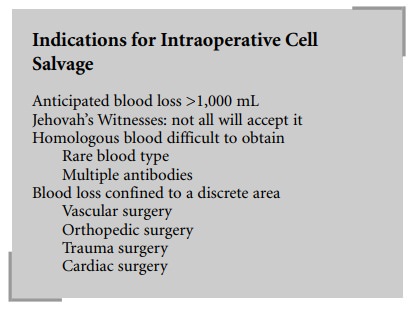Chapter: Clinical Cases in Anesthesia : Blood Replacement
Explain the controversies and contraindications involving intraoperative cell salvage
Explain the controversies and contraindications involving intraoperative
cell salvage.
The major controversies regarding
intraoperative cell sal-vage involve its use in oncologic surgery, and in
contaminated trauma cases. In both situations, questions arise concerning the
possibility of intravascular dissemination of unwanted material—in one case
tumor cells, in the other case bacteria—by the use of cell salvage.
It has been demonstrated that during oncologic surgery tumor cells may survive processing and be suspended, along with red cells, for transfusion back to the patient. Thus, some experts feel that intraoperative cell salvage should not be used during oncologic surgery.

However, it has not been demonstrated that transfusion of malignant cells
results in dissemination of the tumor. In many forms of cancer, tumor cells may
be recovered from blood despite the fact that blood-borne spread does not
occur. There is particular reason for wishing to avoid the use of homolo-gous
transfusion in oncologic surgery. Homologous trans-fusions have been shown to
produce an immunosuppressive effect, resulting in earlier tumor recurrence and
decreased survival times in patients with some forms of cancer. Intraoperative
cell salvage may be advantageous in such cases. One group of studies has looked
at outcome of cell salvage in patients undergoing major urologic oncologic
procedures. No evidence of blood-borne dissemination or high tumor recurrence
rates was found in these patients. Use of cell salvage in such cases has been
recommended by some. It is possible to compromise by using the cell salvage
suction during dissection of tumor-free areas, while employing a separate
suction to collect and discard material during actual tumor dissection.
Nonetheless, more clinical studies will be necessary to fully resolve this
issue.
In abdominal trauma, shed blood is frequently
contam-inated by intestinal contents. Because of red cell binding, bacteria
survive processing by cell salvage equipment and can be transfused back to the
patient. Whether transfusion of such contaminated blood contributes to the
morbidity is questionable. Many experts feel that such patients are exposed to
a bacterial load by the nature of their injuries. Prophylactic antibiotics
significantly reduce the risk of sepsis. Consequently, there is little
additional danger from bacteria in salvaged blood, and patients are spared the
dangers associated with homologous blood. Some authors feel that salvaged
contaminated blood should be used only as a lifesaving measure when no other
blood is available. A definitive answer to this question awaits further
clinical trials.
Cell salvage should not be used in the presence
of topical hemostatic agents, povidone-iodine, polymyxin, bacitracin, or other
topical antibiotics used with irrigation solutions. Its use is presently
contraindicated if shed blood is contaminated by amniotic fluid.
Present cell salvage technology requires
specially trained personnel to operate the equipment. These individuals should
be free from other activities during processing. Consequently, someone other
than the anesthesiologist caring for the patient should receive this
responsibility.
Related Topics